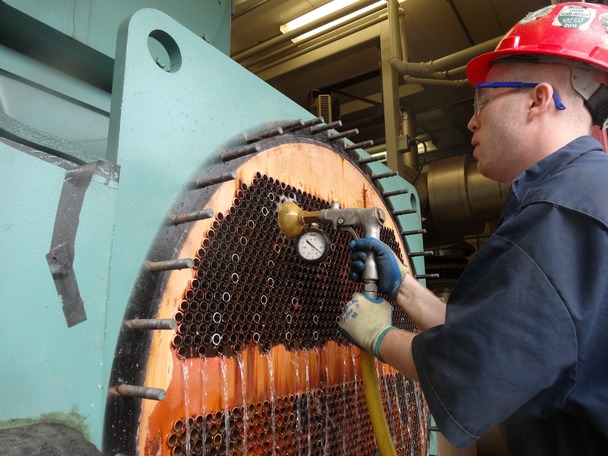Introduction
Cooling Towers Safety Guidelines are essential components in various industries, serving to dissipate heat from industrial processes and power generation systems. However, with their complex operations and high-risk environments, ensuring the safety of both personnel and equipment is crucial. Adopting advanced safety guidelines and technologies is necessary to prevent accidents, enhance operational reliability, and reduce environmental impact. From vibration control to smart monitoring systems, the implementation of comprehensive safety measures can mitigate risks associated with cooling tower operations, ensuring the health and safety of workers and the continuous functionality of the equipment.
Anti-Vibration Systems:
Cooling towers often experience mechanical vibrations from motors, fans, and water flow. Installing anti-vibration mounts or isolators can mitigate these vibrations, preventing wear and tear on structural components. Reduced vibration enhances safety by minimizing the chances of structural fatigue and component failure, ensuring long-term operational reliability.
Advanced Cooling Tower Safety Guidelines
Thermal Stress Management:
Cooling towers operate in high-temperature environments, which can cause materials to expand and contract, leading to cracks or deformations. Using temperature-resistant materials such as specialized composites or alloys ensures the tower withstands extreme temperature variations. Incorporating thermal expansion joints can also alleviate stress in critical sections.
Remote Monitoring and Control Systems:
Incorporate IoT-based systems for real-time monitoring and control of critical parameters like water temperature, fan speed, and chemical levels. These systems allow operators to manage cooling tower operations remotely, reducing the need for physical inspections in hazardous areas. Automated alerts can notify operators of anomalies, preventing safety risks before they escalate.
Biofilm Prevention Technology:
Biofilm buildup in cooling tower water systems is a common safety and efficiency concern. Employing UV disinfection systems or advanced oxidizing agents like ozone generators helps in controlling microbial growth. These technologies reduce the risk of Legionella bacteria outbreaks, ensuring compliance with health standards.
Weatherproofing and Structural Reinforcement:
In regions prone to extreme weather, reinforce cooling tower structures to withstand high winds, heavy rainfall, or freezing temperatures. This includes adding hurricane braces and waterproof seals to protect sensitive components. Installing heating coils or antifreeze systems for winter operations prevents ice formation that could damage the tower.
Fire-Resistant Fill Materials:
Standard fill materials in cooling towers can pose fire risks. Opting for fire-retardant fills like polypropylene with flame inhibitors significantly reduces the risk of fire spread. Regular fire safety audits and fire suppression systems like sprinklers provide an additional layer of safety.
Automated Chemical Dosing Systems:
Manually adding water treatment chemicals can lead to errors or overexposure. Automated dosing systems use precise sensors to measure and add the correct amount of chemicals, reducing human error, enhancing safety, and improving water treatment efficiency.
Corrosion Monitoring Sensors:
Over time, cooling tower components can corrode due to water and chemical exposure. Installing real-time corrosion sensors can detect early signs of deterioration in critical areas such as pipes, headers, and nozzles. Proactive repairs can then prevent accidents or costly replacements.
Drone-Assisted Inspections:
Drones equipped with high-resolution cameras and thermal imaging sensors can safely inspect hard-to-reach areas, such as fan decks, top sections, or confined spaces of Cooling Tower Safety Guidelines. This reduces the risks associated with manual access, such as falls or exposure to hazardous environments.
Water Flow Alarms and Sensors:
Irregular water flow due to blockages, leaks, or pump malfunctions can compromise safety. Installing flow sensors with alarm systems provides immediate alerts, ensuring timely corrective actions. This also helps maintain optimal operational efficiency and prevents water overflow or equipment damage.
Non-Slip Coatings for Walkways:
Wet or icy surfaces on cooling tower walkways and platforms are major safety hazards. Applying non-slip coatings or installing anti-slip mats on all access areas minimizes the risk of slips and falls, especially during maintenance activities.
Dynamic Load Testing:
Periodic dynamic load testing assesses how cooling towers handle operational stresses, including variable loads from water, wind, and equipment of Cooling Tower Safety Guidelines. This ensures the structure remains safe and reliable under fluctuating conditions, preventing unexpected collapses.
Redundant Power Supply Systems:
Critical safety systems like alarms, cooling fans, and monitoring devices require uninterrupted power. Installing backup generators or dual power feeds ensures operations continue during power outages, maintaining safety and preventing system shutdowns.
Emergency Overflow Systems:
Uncontrolled water surges can flood cooling towers, damaging structural components and increasing risks. Overflow drains or reservoir systems can handle excess water, protecting the system from overflow-related failures and ensuring operational continuity.
Enhanced Drift Eliminators:
Drift eliminators prevent water droplets from escaping the tower, which could carry chemicals harmful to workers and the environment. Using high-efficiency eliminators made from corrosion-resistant materials reduces drift emissions, enhancing safety and compliance with environmental standards.
Conclusion
Incorporating robust safety measures and cutting-edge technologies into cooling tower operations is vital for maintaining safe and efficient systems. Through proactive approaches such as corrosion monitoring, drone-assisted inspections, real-time flow alarms, and automation, industries can safeguard their workforce, protect critical infrastructure, and minimize environmental risks. As cooling tower safety evolves, organizations must continuously adapt to new challenges, ensuring that safety remains a top priority. With a commitment to innovation and thorough safety protocols, cooling towers can operate at their highest potential while minimizing risk and enhancing overall operational efficiency.

